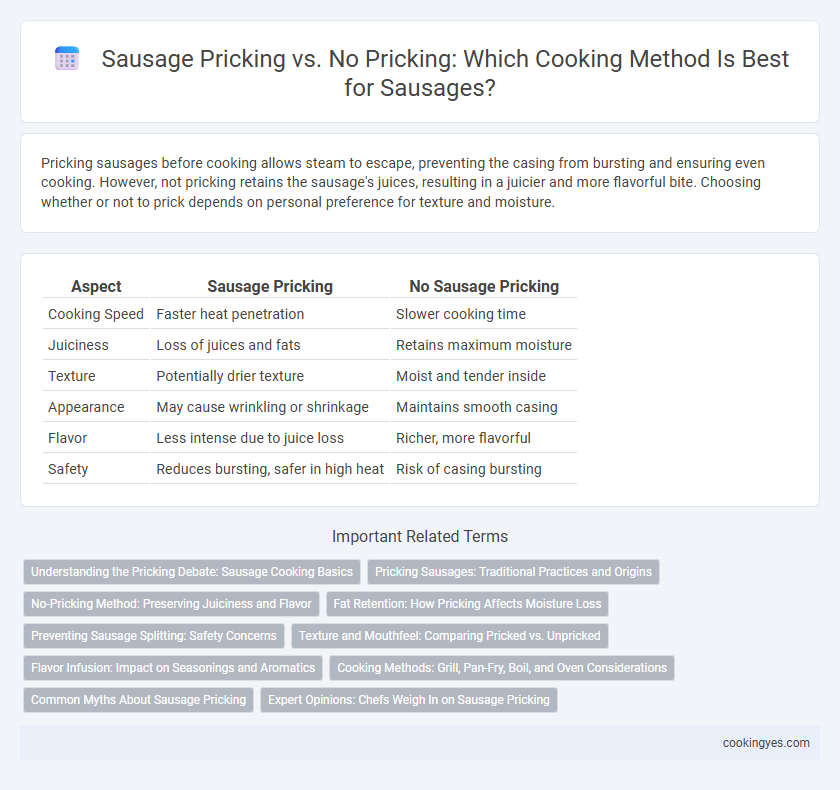Pricking sausages before cooking allows steam to escape, preventing the casing from bursting and ensuring even cooking. However, not pricking retains the sausage's juices, resulting in a juicier and more flavorful bite. Choosing whether or not to prick depends on personal preference for texture and moisture.
Table of Comparison
| Aspect | Sausage Pricking | No Sausage Pricking |
|---|---|---|
| Cooking Speed | Faster heat penetration | Slower cooking time |
| Juiciness | Loss of juices and fats | Retains maximum moisture |
| Texture | Potentially drier texture | Moist and tender inside |
| Appearance | May cause wrinkling or shrinkage | Maintains smooth casing |
| Flavor | Less intense due to juice loss | Richer, more flavorful |
| Safety | Reduces bursting, safer in high heat | Risk of casing bursting |
Understanding the Pricking Debate: Sausage Cooking Basics
Pricking sausages before cooking is debated because it can release juices, potentially drying out the sausage and reducing flavor intensity. Leaving sausages unpricked preserves natural casing integrity, allowing the juices to stay inside, resulting in a juicier texture and enhanced taste. Understanding this debate helps optimize cooking methods for desired sausage quality and flavor retention.
Pricking Sausages: Traditional Practices and Origins
Pricking sausages is a traditional cooking practice believed to release excess air and fat, preventing bursting during grilling or frying and promoting even cooking. Originating in European culinary methods, this technique was used to avoid sausage casing rupture caused by steam buildup. While pricking can help control moisture and texture, modern sausage recipes often recommend unpierced cooking to retain juiciness and flavor.
No-Pricking Method: Preserving Juiciness and Flavor
The no-pricking method for cooking sausages preserves their natural juices and intensifies flavor by preventing the escape of flavorful fats and moisture during cooking. This technique ensures a tender, succulent texture while maintaining the sausage's original seasoning profile. Avoiding pricks also reduces the risk of drying out the sausage, resulting in a more enjoyable eating experience.
Fat Retention: How Pricking Affects Moisture Loss
Pricking sausages before cooking causes fat and juices to escape, leading to drier, less flavorful results due to increased moisture loss. Cooking sausages without pricking helps retain internal fat and moisture, enhancing juiciness and richness. Fat retention during cooking preserves the sausage's texture and overall taste profile, making no-prick methods preferable for optimal flavor.
Preventing Sausage Splitting: Safety Concerns
Pricking sausages before cooking releases steam, reducing the risk of splitting and preventing hot fat from causing burns. However, pricking can also cause loss of juices, resulting in drier meat, so balancing safety and texture is important. Using moderate heat and avoiding overcooking minimizes sausage splitting without compromising safety or flavor.
Texture and Mouthfeel: Comparing Pricked vs. Unpricked
Pricking sausages before cooking allows fat and juices to escape, resulting in a drier texture and a firmer mouthfeel. In contrast, unpricked sausages retain their juices, offering a juicier, more succulent bite with a tender texture. The choice between pricked and unpricked sausages significantly affects the overall eating experience, balancing moisture retention and casing integrity.
Flavor Infusion: Impact on Seasonings and Aromatics
Pricking sausages before cooking allows seasonings and aromatics to penetrate more deeply, enhancing flavor infusion and creating a more intense taste profile. However, pricking can also cause juices to escape, potentially leading to drier sausages with less rich flavor. Leaving sausages unpricked helps retain internal moisture, preserving natural flavors but may limit the depth of seasoning absorption during cooking.
Cooking Methods: Grill, Pan-Fry, Boil, and Oven Considerations
Pricking sausages before grilling or pan-frying can cause juices to escape, leading to drier texture and less flavor, while unpricked sausages retain moisture and juiciness. Boiling sausages without pricking helps maintain their natural casing integrity and prevents the loss of seasonings, ensuring a succulent finish. Oven cooking calls for no pricking to preserve moisture during slow, even heat exposure, resulting in tender and flavorful sausages.
Common Myths About Sausage Pricking
Sausage pricking is often believed to prevent casing rupture by releasing steam during cooking, but this practice can cause loss of flavorful juices, resulting in drier sausages. Many chefs recommend cooking sausages without pricking to retain moisture and enhance taste, as the natural casing typically allows sufficient steam escape. Scientific tests show no significant difference in cooking safety or outcome between pricked and unpricked sausages, debunking the myth that pricking is essential.
Expert Opinions: Chefs Weigh In on Sausage Pricking
Expert chefs advise against pricking sausages before cooking to preserve juicy flavors and prevent dryness, as piercing causes valuable juices to escape. Culinary specialists highlight that intact casings help maintain optimal moisture, resulting in a tender texture and enhanced taste. Several professional cooks emphasize using indirect heat or slow cooking techniques instead of pricking for best sausage preparation outcomes.
Sausage pricking vs no pricking for cooking method Infographic

 cookingyes.com
cookingyes.com